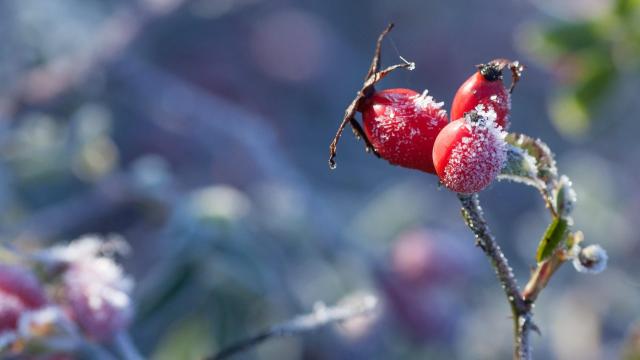The first freezing night of autumn can be disastrous for your garden. Although some plants thrive in low temperatures, many others die at the merest kiss of frost. Don’t get caught out in the cold — here’s how to get ready for the first frost of the season.
Predict when it’ll happen
Before you can start frost prep in earnest, it helps to know when to expect that first overnight freeze. This is as easy as plugging your zip code into a frost date calculator, like this one from the Old Farmer’s Almanac (OFA). Frost calculators pull temperature data from national databases and use them to estimate average first and last frost dates for a given region. (The OFA tool uses data from the National Oceanic and Atmospheric Administration’s (NOAA) Centres for Environmental Information.) Keep in mind that these dates are averages based on historical data, so the actual first frost may or may not line up with the calculator’s prediction.
This is where your local weather report comes in handy. During the growing season, meteorologists will issue cold weather warnings so farmers can plan accordingly. Here are three commonly used terms and their definitions from the National Weather Service (NWS) Glossary:
- Frost advisory: Widespread frost formation is expected, with surface temperatures usually in the 0-4 degrees C.
- Freeze warning: Surface temperatures at or below 0ºC are expected, over a large area, and for an extended period of time.
- Freeze watch: Sub-freezing surface temperatures possible sometime in the next 24-26 hours.
Used alone, neither frost calculators nor forecasts give you quite enough information to go on, so it’s best to use both. Get a rough timeframe with a calculator first, then keep an eye on the forecast so you don’t miss any warnings.
Categorise your plants by hardiness
Cold temperatures affect different plants in different ways. To best protect yours, you need to know which of your plants will survive a light frost and which won’t. “Tender” plants — anything with delicate leaves, flowers, and/or fruit — fare worse in sub-freezing temperatures than “hardy” plants. Some hardy vegetables, including broccoli, most root vegetables, and Brussels sprouts, actually taste better after a freeze. (According to an OFA blog post on frost protection, “root crops develop more sugars when the soil temperature is below 4ºC,” which is pretty neat.)
The best way to figure out if a plant is hardy, tender, or somewhere in between is to Google its frost damage threshold or frost damage temperature. This will tell you how cold it has to get overnight for the plant to die, which will clue you in to proper protective strategies.
Harvest tender plants (or bring them inside)
Tender plants that won’t survive even a little frost should be your top priority. Before the first frost, make sure to harvest the last of your summer crops, like tomatoes, squash, corn, and tender herbs like parsley or cilantro. Potted plants fall into this category as well, even if they don’t contain typical “tender” plants — they don’t have enough soil volume to hold onto heat. Be sure to bring your potted plants inside to a spot with appropriate light so they stay safe and warm all winter long.
Protect everything else
Hardy plants may survive a brief stint of freezing weather, but they still need a little help. Here are some easy, Old Farmer’s Almanac-approved techniques for protecting your plants and their soil:
- Water thoroughly: Moist soil holds more heat than dry soil, so give everything a generous amount of water a few days before the first frost.
- Mulch, mulch, mulch: Blanketing bare soil and low plants with mulch adds another layer of insulation and fertilizes the soil as it decays
- Cover plants and garden beds: Loosely cover any exposed plants with polyester row covers, bed sheets, or drop cloths, and secure them with something heavy
If you’re thinking these are all fairly standard winterizing techniques, you’re right. When it comes to frost prep, what you do matters less than when you do it. Get your timeline in order, and always keep an eye on the forecast; everything else will follow from there.

Leave a Reply
You must be logged in to post a comment.